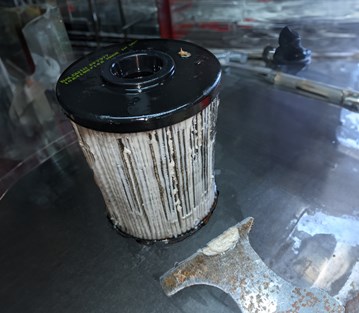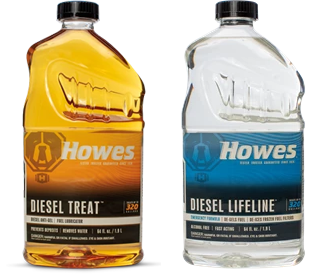
10/31/25
Diesel, Anti-gel, Diesel Treat, Diesel Lifeline, Gelling
By Rich Guida
During a surprise winter storm, one trucker tried to “thin” his diesel with gasoline, a trick he learned from outdated advice. Instead of keeping his fuel flowing, the mix caused his engine to knock and stall. Stories like this are unfortunately all too common because many diesel drivers still rely on old lore.
At Howes, we hear from fleets and owner‑operators every winter who suffer costly breakdowns after attempting home remedies. This article explains how diesel behaves in the cold, why adding gasoline or straight kerosene is a bad idea, and the professional steps that protect your engine when temperatures plummet.
Diesel is a complex blend of hydrocarbons. The heavier molecules include paraffin wax, which gives diesel its high energy content. When temperatures fall, these waxes begin to crystallize. At the cloud point the fuel turns hazy as wax crystals form. When enough wax appears to clog a typical filter you hit the Cold Filter Plugging Point (CFPP), commonly called “gelling.” If it gets even colder, the fuel reaches its pour point where it no longer flows. Untreated #2 diesel can gel around 32 °F and thinning it with a solvent does nothing to change how wax crystals form.

People often think adding gasoline will “thin” diesel and lower its gel point. In reality, gasoline’s lower flash point turns your diesel engine into a ticking time bomb. Adding just 1% gasoline drops the flash point of your fuel by around 65 °F. Modern diesel engines are tuned to ignite at a specific temperature and pressure, and lowering the flash point causes the fuel to ignite too early. Early ignition is a quick way to destroy your diesel engine and leads to expensive repairs. Beyond that, gasoline offers little or no lubrication and introduces other problems:
Modern high‑pressure common‑rail systems aren’t as forgiving as older mechanical engines. If you have already added gasoline to your fuel tank, do not run the engine. Have the tank drained and the lines flushed before damage occurs.
Kerosene, or #1 diesel, has been used historically to fight gelling because it has a lower cloud point. Blending it with #2 fuel does lower the temperature at which wax begins to crystallize. However, the benefit is small. Compared to diesel anti-gel additives, kerosene lowers the gel point significantly less.
Kerosene also brings drawbacks that are unacceptable for modern engines:
If you run an older engine designed for kerosene, follow the manufacturer’s guidelines. Otherwise, leave kerosene blending to refinery professionals who add proper lubricity packages.
Instead of guessing at fuel cocktails, use a winter diesel fuel additive. These additives chemically change how wax crystals form so that they don’t clog your fuel filter. A good additive can lower the operable temperature by at least 20 °F. In very cold weather, such as 0 °F or below, winter diesel additive manufacturers may recommend a higher dosage for potency. Many additives also demulsify water, add lubricity, and include cetane boosters, offering additional benefits for the longevity of your diesel engine. Using a trusted anti-gel diesel additive like Howes Diesel Treat before freezing temperatures arrive is key to ensuring it circulates through your whole fuel system for full protection.

Experienced diesel mechanics and fleet managers recommend products that deliver results, which is why Howes Diesel Treat has earned a reputation as North America’s most trusted anti‑gel diesel additive. It uses a petroleum base with specialized cold‑flow improvers to prevent gelling and safely demulsify water, the preferred method of water removal. Unlike treatments containing harmful alcohols or solvents, it won’t damage seals. Diesel Treat also adds lubricity to ultra‑low sulfur diesel, protecting pumps and injectors, and contains detergents to keep injectors clean. Cleaning the injection system reduces smoke and rough idle. It’s safe for any diesel or biodiesel blend, and Howes backs it with both a money back guarantee and a free tow guarantee. Fleet operators report fewer cold‑weather issues when they use Diesel Treat as a preventive measure instead of relying on home remedies.

Even prepared drivers can get caught off guard by sudden cold fronts. Howes Diesel Lifeline is designed for these situations. It re‑liquefies gelled fuel and de‑ices frozen filters without alcohol, often restoring flow within 15 minutes. It also adds lubricity to protect components once the engine is running. Carrying a bottle of Diesel Lifeline in your truck can mean the difference between a quick fix and a tow in sub‑zero temperatures.
To stay ahead of winter, adopt these simple habits:
Carry rescue fluid: Keep a bottle of Diesel Lifeline or similar product handy.
When winter weather hits, your diesel engine needs proper care, not experimentation. Adding gasoline lowers the flash point and strips lubricity, leading to misfires and damage. Kerosene provides only a small cold‑flow improvement while reducing power and lubricity. Modern diesel engines and ULSD fuel make old tricks obsolete. Instead, rely on proven diesel anti-gel additives like Howes Diesel Treat. And, it’s always a good idea to keep a rescue treatment like Diesel Lifeline on board just in case. With these tools you’ll be ready for the cold without risking damaging your diesel engine.